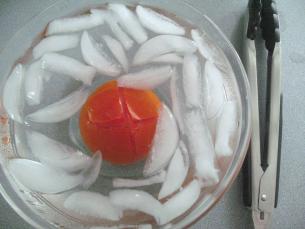Today’s tomato round-up not only includes How to Peel and Seed a Tomato, but also:
- How to Buy and Store Fresh Tomatoes
- How to Peel and Seed A Tomato
- How to Freeze Tomatoes
- Buying the Best Canned Tomatoes
- And finally Links to Great Tomato Recipes
How to Buy and Store Tomatoes
When you pick up a good tomato, it should feel heavy for its size and have a distinct tomato-y smell. It should have a little “give” when you feel it, but not be mushy, and the skin should not be bruised or have blemishes or cracks.
The best place to get tomatoes is in your own backyard vegetable garden or from a local farmer’s market. Tomatoes in the grocery store are often picked before they’re ready, artificially ripened, and not as flavorful as the locally grown fresh varieties. Canned tomatoes can often be better than the tomatoes in the grocery store.
Do not refrigerate tomatoes, because their texture will change; they’ll become mealy. Instead, store them on your counter top in a cool, dry spot, stem side down. Don’t stack them on top of each other, because they’ll tend to make each other mushy. Store them in a single layer.
There are roughly three types of tomatoes generally found at the grocery store.
1. Slicing tomatoes:
One popular kind is the beefsteak tomato.

It is grown for fresh use, and it yields large slices perfect for sandwiches! Look for the sign or the label on the tomato itself.

2. Paste/Canning tomatoes:
These are often smaller and more oblong-shaped than slicing tomatoes. They tend to be meatier and have fewer seeds – perfect for making sauces with creamy texture and lots of flavor, or canning for the long winter! One popular variety is the Roma tomato. These are also known as “plum tomatoes.”
3. Tiny ones:
Cherry tomatoes and grape tomatoes are the most popular. These are great for adding tomato flavor to dishes without any of the moisture associated with the cut fruit — perfect for pasta salads or green salads!
In the summertime, especially at Farmer’s Markets, there are of course, many more varieties of tomatoes available. Here’s a great website with a description and photos of dozens of tomatoes.
How to Peel and Seed a Tomato
Some of you might be thinking – “why do I ever need to peel and seed a tomato?”
It can be a matter of preference but, generally speaking, for recipes with quick cooking times it is best to peel the tomatoes. Recipes that call for a long simmering time usually do not have you peel the tomatoes. In my Guacamole recipe I do not peel the tomato but I do seed it as all those extra seeds (and juice) really throw off the texture and can make it watery.
Start by cutting an X in the bottom of the tomato with a very sharp knife. You want to just pierce the skin.
If you are peeling just one or two (or three!) tomatoes put them in a heat-proof (Pyrex) bowl big enough so that when you add the water they will be totally covered.
Pour BOILING water over the tomato(es.)
Within about 10-15 seconds, the skin will have burst. (There are some who say to leave the tomato in the water for 3-to-4 minutes. WRONG! You do not want the tomato to cook and get mushy.)
Remove the tomato from the water with a pair of tongs.
You can also do this in a pot of boiling water, using tongs to add and remove the tomato from the pot.
Prepare an ice-bath, which is just a bowl of water with ice cubes in it.

Using tongs, drop the tomato into the ice bath.

This cools off the tomato and stops the cooking process. Remove the tomato from the ice bath and the skin now just slips off…
…and the tomato is all peeled.
To remove the seeds, cut the tomato in half with the blade of the knife parallel to the stem.
You can gently squeeze the tomato to remove the seeds, or just ease them out with your finger.
Once tomatoes are peeled and seeded they can get added to salads, dips, sauces, cold soups, etc.
The longest part of the entire process of peeling and seeding a tomato is boiling the water!
How to Freeze Tomatoes
If your garden is bursting with fresh tomatoes you can actually freeze raw tomatoes.
The University of Nebraska’s Alice Henneman (MS, RD, UNL Extension in Lancaster County) has described how you would go about freezing raw tomatoes:
“Tomatoes may be frozen whole, sliced, chopped, or puréed. Additionally, you can freeze them raw or cooked, as juice or sauce, or prepared in the recipe of your choice. Thawed raw tomatoes may be used in any cooked-tomato recipe. Do not try to substitute them for fresh tomatoes, however, since freezing causes their texture to become mushy. Tomatoes should be seasoned just before serving rather than before freezing; freezing may either strengthen or weaken seasonings such as garlic, onion, and herbs.
Preparation:
Select firm, ripe tomatoes for freezing. Sort the tomatoes, discarding any that are spoiled. Wash them in clean water. Dry them by blotting with a clean cloth or paper towels.
Freezing whole tomatoes with peels:
Prepare tomatoes as described above. Cut away the stem. Place the uncut tomatoes on cookie sheets and freeze. Tomatoes do not need to be blanched before freezing. Once frozen, transfer the tomatoes from the cookie sheets into freezer bags or other containers. Seal tightly.
To use the frozen tomatoes, remove them from the freezer a few at a time or all at once. To peel, just run a frozen tomato under warm water in the kitchen sink. Its skin will slip off easily.
Freezing peeled tomatoes:
If you prefer to freeze peeled tomatoes, you can wash the tomatoes and then dip them in boiling water for about 1 minute or until the skins split. Peel and then freeze as noted above.
For more information on freezing tomatoes: Check this link to the National Center for Home Food Preservation, hosted by the University of Georgia Cooperative Extension Service: Freezing Tomatoes
Storage time
To extend the time frozen foods maintain good quality, package foods in material intended for freezing (that means proper freezer bags, not just any bag that’s left over from the produce section of the grocery store). Keep the temperature of the freezer at 0 degrees F or below. It is generally recommended frozen vegetables be eaten within about 8 months for best quality.”
Buying the Best Canned Tomatoes
(From this point onward, I need to extend an apology to my world wide audience. The following reviews are based on canned tomatoes available in the United States. I would love it if any of my overseas readers could add in the comment section what canned tomatoes they could recommend from their country of origin. Thanks!)
All canned tomatoes are not the same. One should not dismiss canned tomatoes if the first brand you try does not meet your standards. There are many to choose from. Please keep in mind that some brands may have superior canned whole tomatoes but their “roasted” canned tomatoes are rated inferior. This is one purchase where you really need to read the label carefully!
Chris Kimbal, over at America’s Test Kitchens, provides a useful guide. One of the many wonderful things they do at America’s Test Kitchen is test ingredients.
Here is a quick summary of their recommendations on what canned tomatoes, diced tomatoes, and tomato puree they recommend:
WHOLE CANNED TOMATOES- HIGHLY RECOMMENDED:
- PROGRESSO Italian-Style Whole Peeled Tomatoes with Basil
- REDPACK Whole Peeled Tomatoes in Thick Puree
- HUNT’S Whole Tomatoes
DICED TOMATOES- HIGHLY RECOMMENDED
- MUIR GLEN Organic Diced Tomatoes
- REDPACK Diced Tomatoes (REDGOLD on the West Coast)
TOMATO PUREE RECOMMENDED
- HUNT’S: “Nice and thick,” “tomatoey.”
- PROGRESSO: “Thick,” “tastes kind of fresh.”
- CENTO: “Balanced, good flavor,” “slightly bitter.”
- MUIR GLEN: “Thick and strong,” “good flavor.”
- PASTENE: “Fresh tasting, “tinny.”
- REDPACK: “Velvety smooth texture, “very acidic.”
- CONTADINA: “Good balance,” “slightly sour.”
- RIENZI: “Vegetable flavor,” “very thin.”
If you would like a more in depth description of America’s Test Kitchen Review, head on over to America’s Test Kitchen and sign in! Thanks ATK!
(Note: America’s Test Kitchen is a fabulous site but not everything is available for free. To have complete access to ATK you will need to pay an annual fee.)
Links to Some Great Tomato Recipes!
Fresh basil is fragrant and delicious! My Marinara Sauce uses canned tomatoes with a nice big bunch of fresh basil. You can wash fresh basil the same way you wash lettuce.
One of the easiest ways to use tomatoes is in Insalata Caprese, an Italian salad that combines tomatoes, fresh mozzarella cheese, fresh basil and olive oil. It’s that simple!
A basic Tomato Sauce Recipe can be made and frozen for future use.
Home made Tomato Soup is surprising easy to make and it is m-m-m-m good!
When summer is bursting with fresh tomatoes and high temperatures, cold Gazpacho is a filling and refreshing soup.
Pasta Salad is the perfect meal to enjoy all year round. Bow-tie pasta, salami, olives, green onions, feta or goat cheese, and of course tomatoes make this salad a summer favorite!
This one’s got a long name, but it’s so mouth-wateringly delicious-sounding that I have to tell you the whole thing: Tomato and Fresh Basil Crostini (toast) with Feta and Roasted Garlic Cheese Spread…mmm. A great appetizer similar to bruschetta.
Tomato pie in a flaky pastry crust is a classically southern way to enjoy your garden’s abundance of tomatoes. (Emily’s pie used peeled tomatoes and it looks delicious!)
Tomatoes stuffed with rice are an easy and elegant dish to serve your summer dinner party guests. Try adding vegetables, sausage pieces, or ground beef to your rice mixture.
Fried green tomatoes are another classically southern dish. Green tomatoes have a tangier taste than red ones, and when breaded and fried, they make a crispy and fresh appetizer, addition to sandwiches, or side for crab cakes.
Don’t forget about the classic BLT sandwich!
Taboule (shown below) will keep you cool because there’s no cooking involved! Plus, with fresh flavors like tomato, lemon, and mint, you can’t go wrong.
Cheers!
Kathy
If you are new to startcooking, or are a regular visitor here, please consider subscribing for free.









































Daniel said:
This is good stuff! The pictures are great too. Thanks